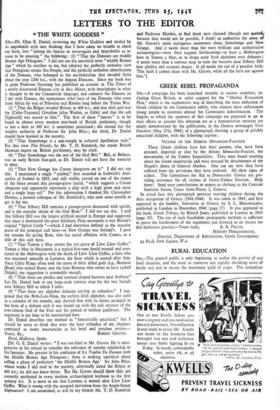LETTERS TO THE EDITOR
THE WHITE GODDESS "
Sla,—Dr. Glyn E. Daniel, reviewing my White Goddess and misled by its unpedantic style into thinking that I have taken no trouble to check
my facts, lists " among the fancies so extravagant and improbable as to
cease to be amusing " the following: (1) "That the Danaans are middle Bronze Age Pelasgians." I did not use the uncritical term "middle Bronze
Age " which he ascribes to me, but adopted the perfectly orthodox view that Pelasgians means Sea-People, and the perfectly orthodox identification of the Danuna, who belonged to the sea-federation that invaded Syria about the year 1200 B.C., with the Aegean Danaans. Since my book was
in print Professor Garstang has published an account in The Times of a newly discovered Danuna city in Asia Minor, with inscriptions in what
is thought to be the Canaanitish language, and connects the Danuna (as I do) with Danaus, the eponymous tribal hero of the Danaans who came from Africa by way of Palestine and Rhodes long before the Trojan War.
(2) "That the Belgae invaded Britain in 400 B.C., and that their god was the [Celto-Teutonic] Gwydion [alias Woden, or Odin] and that the ash [Ygdrasill] was sacred to him." The first of these " fancies" is to be found in almost every modem text-book of British prehistory, though so late a date as 180 B.C. is sometimes postulated ; the second has the weighty authority of Professor Sir John Rhys ; the third, Dr. Daniel should have learned in the nursery.
(3) " That Stonehenge is a sun-temple in cultured Apollonian style." For this view The Druids, by Mr. T. D. Kendrick, the senior British Museum expert on British pre-history, may be cited.
(4) "That Stonehenge was the seat of the God Beli." Beli, or Belinus, was an early British Sun-god, as Dr. Daniel will not have the temerity to deny.
(5) " That New Grange has Cretan ideograms on it." I did not say this. I mentioned a single " symbol," first recorded in Ledwich's Anti- quities of Ireland in 1803, and still visible, carved on one of the stones
of the fence around this passage-grave burial, " which suggests a Cretan ideogram and apparently represents a ship with a high prow and stern and a single large sail." For this information I thanked Mr. Christopher Hawkes, a learned colleague of Mr. Kendrick's, who took some trouble to get it for me.
(6) " That Silbury Hill contains a passage-grave decorated with spirals, and is the oracular shrine of the God Bran." I did not say this. I said
that Silbury Hill was the largest artificial mound in Europe and suggested that since it dominated the great Salisbury Plain necropolis it was Britain's original " Spiral Castle "—which I had elsewhere defined as the oracular grave of the principal cult hero—as New Grange was Ireland's. I gave my reasons for giving Bran, who has sacral affinities with Cronos, as a title of this cult hero.
(7) " That Tomen y Mur covers the cist grave of Llew Llaw Gyffes." Tomen y Mur in Merioneth is a typical kist-vaen burial mound and asso- ciated in the Mabinogion with the death of Llew Llaw Gyffes, a hero who was mourned annually at Lammas, the feast which is named after him. Since Celtic Kings often took the name of their tribal gods (e.g., Brennus [Bran] who sacked Rome and the later Brennus who seems to have sacked Delphi), my suggestion is reasonable enough.
(8) " That there are phallus and scrotum shaped barrows near Avebury" Let Dr. Daniel look at any large-scale contour map for the two burials near Silbury Hill to which I refer.
(9) " That there are alphabet dolmens serving as calendars." I sug- gested that the Beth-Luis-Nion, the earliest Irish alphabet, was also used as a calendar of the months, and showed that with its letters arranged in the form of a dolmen arch it was bound up with the cult mystery of the ever-reborn God of the Year and his pentad of tutelary goddesses. The argument is too long to be summarised here.
Dr. Daniel describes my method as " fantastically uncritical," but I should be sorry to think that even the least orthodox of my chapters contained as many inaccuracies as his brief and petulant review.—
Yours, &c., ROBERT GRAVES. Deyd, Mallorca, Spain.
[Dr. G. E. Daniel writes: "I was too kind to Mr. Graves. He is unre- generate in his refusal to consider the relevance of current scholarship to his fantasies. He persists in his confusion of the Tuatha De Danaan with
the Middle Bronze Age Pelasgians ; there is nothing uncritical about
calling a phase of prehistory ' the Middle Bronze Age.' Sir John Rhys, whose works I did read in the nursery, admittedly dated the Belgae at 400 B.c.; he did not know better. But Mr. Graves should know they are correctly attributed in every modern archaeological textbook to the first century a.c. It is news to me that Lammas is named after Llew Llaw Gyffes. What is wrong with the accepted derivation from the Anglo-Saxon hlafmaesse? I am astonished, as will be my friends Mr. T., D. Kendrick and Professor Hawkes, to find them now claimed (though not quoteeio because that would not be possible, I think) as authorities for some of Mr. Graves's more outrageous statements about Stonehenge and New Grange. And it needs more than the most brilliant and authoritative archaeologists—were their support forthcoming—to bury a Mabinogion hero in Tomen y Mur, or to drape early Irish alphabets over dolmens ; it needs more than a contour map to turn the barrows near Silbury Hill into phallus and scrotum shapes. It all needs the eye of a peculiar faith. This faith I cannot share with Mr. Graves, while all the facts are against him."]






























 Previous page
Previous page